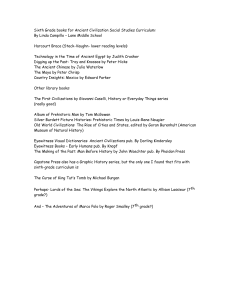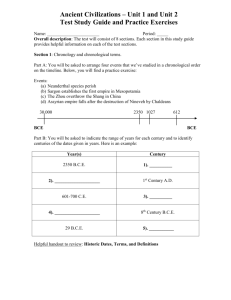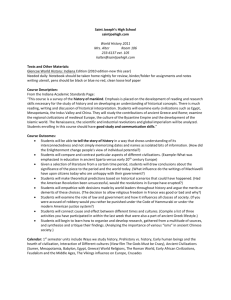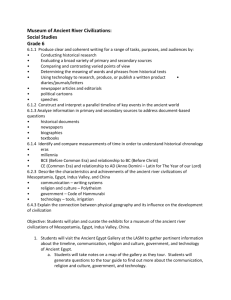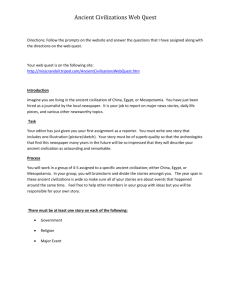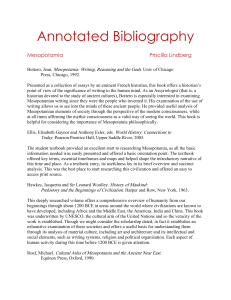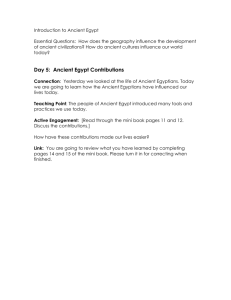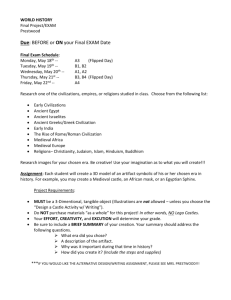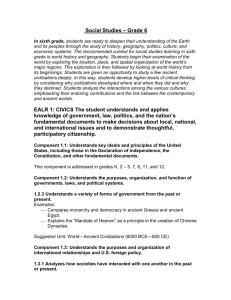30:725:424:01 History of Pharmacy and Medicine
advertisement
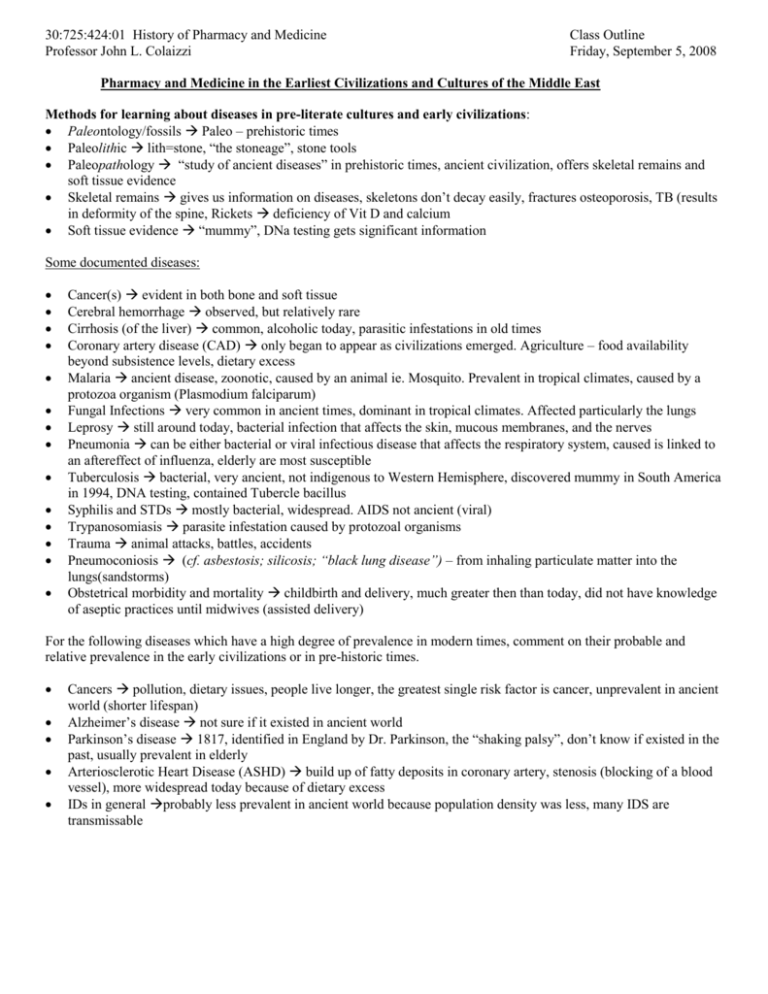
30:725:424:01 History of Pharmacy and Medicine Professor John L. Colaizzi Class Outline Friday, September 5, 2008 Pharmacy and Medicine in the Earliest Civilizations and Cultures of the Middle East Methods for learning about diseases in pre-literate cultures and early civilizations: Paleontology/fossils Paleo – prehistoric times Paleolithic lith=stone, “the stoneage”, stone tools Paleopathology “study of ancient diseases” in prehistoric times, ancient civilization, offers skeletal remains and soft tissue evidence Skeletal remains gives us information on diseases, skeletons don’t decay easily, fractures osteoporosis, TB (results in deformity of the spine, Rickets deficiency of Vit D and calcium Soft tissue evidence “mummy”, DNa testing gets significant information Some documented diseases: Cancer(s) evident in both bone and soft tissue Cerebral hemorrhage observed, but relatively rare Cirrhosis (of the liver) common, alcoholic today, parasitic infestations in old times Coronary artery disease (CAD) only began to appear as civilizations emerged. Agriculture – food availability beyond subsistence levels, dietary excess Malaria ancient disease, zoonotic, caused by an animal ie. Mosquito. Prevalent in tropical climates, caused by a protozoa organism (Plasmodium falciparum) Fungal Infections very common in ancient times, dominant in tropical climates. Affected particularly the lungs Leprosy still around today, bacterial infection that affects the skin, mucous membranes, and the nerves Pneumonia can be either bacterial or viral infectious disease that affects the respiratory system, caused is linked to an aftereffect of influenza, elderly are most susceptible Tuberculosis bacterial, very ancient, not indigenous to Western Hemisphere, discovered mummy in South America in 1994, DNA testing, contained Tubercle bacillus Syphilis and STDs mostly bacterial, widespread. AIDS not ancient (viral) Trypanosomiasis parasite infestation caused by protozoal organisms Trauma animal attacks, battles, accidents Pneumoconiosis (cf. asbestosis; silicosis; “black lung disease”) – from inhaling particulate matter into the lungs(sandstorms) Obstetrical morbidity and mortality childbirth and delivery, much greater then than today, did not have knowledge of aseptic practices until midwives (assisted delivery) For the following diseases which have a high degree of prevalence in modern times, comment on their probable and relative prevalence in the early civilizations or in pre-historic times. Cancers pollution, dietary issues, people live longer, the greatest single risk factor is cancer, unprevalent in ancient world (shorter lifespan) Alzheimer’s disease not sure if it existed in ancient world Parkinson’s disease 1817, identified in England by Dr. Parkinson, the “shaking palsy”, don’t know if existed in the past, usually prevalent in elderly Arteriosclerotic Heart Disease (ASHD) build up of fatty deposits in coronary artery, stenosis (blocking of a blood vessel), more widespread today because of dietary excess IDs in general probably less prevalent in ancient world because population density was less, many IDS are transmissable Theoretical basis for disease causation (etiology), cure, prevention or treatment Earliest civilizations – the prehistoric period, emergence of writing, agriculture, occupations, 1. Mesopotamia – between Tigres and Euphrates 2. China 3. India Comparisons with Western (Allopathic) Medicine (“Empirical therapy to true science”) – very empirical (trial and error) Therapeutic approaches of early civilizations emphasized ________cleansing________ and ________purging_________ with the idea of ____________purification______________ by the expulsion of evil spirits or influences (and sin). Examples of such therapeutic approaches: Purgatives (purging agents) powerful evacuants of the lower colon Cathartics less harsh than purgatives Laxatives more gentle than cathartics Enemas (clysters) same as purgatives, inserted rectally Venepuncture, Venesection, phlebotomy bleeding, blood-letting, popular for treatment of many diseases, up until 18th century, early 19th, no scientific basis Medicinal Leeches (Hirudo Medicinalis) bloodsucking worms that attach to skin and suck out blood, prevalently sold in pharmacies in the early 20th century In ancient civilizations, the administration of certain medications was accompanied by ritualism and incantations (chanted prayers). Examples: Soil/clay samples used often, administered orally, topically, contains active drug substances antimicrobials, antacid, antidiarrheal Fungi (from mummy), topically, orally, psychoactive properties, antimicrobial(Iceman) Scarifications and tattoos tribes in Africa today, intradermal injections (not as deep as IM and SC), pustules (dried up scabs from small pox), would induce immunization of ancient form, snake venom (immunity from future snake bites), and dyes Opium fundamental base of narcotic analgesics Alcohol religious rituals o Opium and alcohol are common in CNS depressants, have addictive properties Mesopotamia: the first definitive written records of drugs used as medicines: Mesopotamia, Babylonia, Sumaria, Chaldea, Iraq refer to same civilization Dates associated with the “Clay Tablets” 3000 BC Cuneiform writing wedge-shaped characters Types of drugs represented on the Clay Tablets botanical, mineral, animal parts, opium, cannabis The Code of King Hammurabi of Babylon: Hammurabi’s identity – very well documented king and military ruler in present day Iraq 1792-1750 BC Hammurabi’s well-documented “Code” and its influence on the historical development of medicine and subsequent healthcare professions – o First documented evidence of laws and regulations related to healthcare o 182 laws and regulations, severe punishments for malpractice o Tiered reimbursements – rich(more pay), slaves (less), legal and regulatory o Hippocrates added ethics and care

